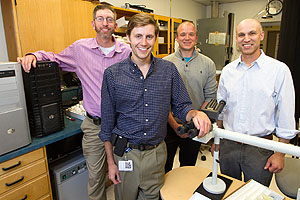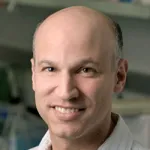
Figure of mutation frequency, distribution and relationship with pathological features from publication in Nature Genetics.
May 25th, 2014, Inside Stanford Medicine, by Patricia Waldron
Researchers at the Stanford University School of Medicine have identified the mutations underlying a rare, understudied type of jaw tumor called ameloblastoma.
In a paper published online May 25 in Nature Genetics, the researchers identify mutations in two genes that are associated with 80 percent of ameloblastoma cases. The Food and Drug Administration has already approved drugs for other cancers caused by these mutations. Now, the paper’s authors are pursuing funding for a pilot study to use one of these drugs to treat ameloblastoma.
Doctors diagnose about 300 to 600 cases of ameloblastoma in the United States each year. Neither drugs nor radiation have been successful at eradicating the cancer, leaving surgery as the only option. Though the tumors are considered benign, surgeons must cut away large margins around the growths to try to ensure that it will not reoccur. Because the operation removes a portion of the jaw as well as arteries and facial nerves, the patients require extensive reconstructive surgeries and rehabilitation to regain the ability to smile and chew.
“They require quite a disfiguring surgery to treat,” said Andrew McClary, MD, chief pathology resident at Stanford Hospital & Clinics. Patients often lose a large section of their jaw, he said. McClary shares lead authorship of the paper with postdoctoral scholars Robert Sweeney, MD, and Benjamin Myers, PhD, and with research assistant Jewison Biscocho.
The quest to find underlying mutations
McClary first became interested in this rare disease when he examined a slide from a patient’s tumor. He often uses a mnemonic trick to remember a disease by associating its name with the gene mutations that cause it. But he found that ameloblastomas had no known gene abnormalities.
To find the underlying mutations causing these tumors, McClary worked with colleagues at the University of British Columbia in Vancouver, the Cleveland Clinic in Ohio and the Oregon Health Sciences University in Portland to collect tumor samples. Because the disease is so rare, they only had older bits of tissue that had been preserved for microscopy work, not genetic studies.
Fortunately, the researchers still were able to sequence the mRNA — copies of genes that tell the cell how to make specific proteins — even when the mRNA was old and degraded. The researchers then embarked on what McClary called a “fishing expedition” to find the mRNAs with the mutations that caused the tumors.

Photo by Norbert von der Groeben of researchers Robert
West, Andrew McClary, Robert Sweeney and Jonathan
Pollack and their colleagues found two genes that are
linked with a majority of cases of a rare type of jaw tumor.
By sequencing all the mRNAs in two ameloblastoma samples, they identified two genes that carried mutations involved in growth and development, called SMO and BRAF. They then sequenced these genes in additional tissue samples to confirm their presence in other ameloblastomas. SMO mutations were most often found in the upper jaw, while BRAF mutations occurred predominantly in the lower jaw.
“These genes are essential for delivering signals of growth and development, particularly in developing organs,” said Robert West, MD, PhD, associate professor of pathology at Stanford and a senior author of the study. “But it’s increasingly apparent that they are often mutated in cancers.”
Possible therapies
Perhaps most promising, researchers found that there are already FDA-approved drugs for cancers with mutations in the same developmental pathway. A drug called vemurafenib is toxic to ameloblastoma cell cultures that harbor a BRAF mutation, they found. This drug is effective against melanomas that carry the same mutant gene. Researchers also found that a compound called arsenic trioxide, an approved anti-leukemia drug, is effective at blocking the mutant SMO protein.
In April, West and McClary began collaborating with Dimitrios Colevas, MD, associate professor of oncology at Stanford, to plan a small pilot study to assess whether vemurafenib can shrink ameloblastoma tumors that have a BRAF mutation.
In future work, the researchers plan to conduct more fishing expeditions to look for these mutations in other types of tumors, cysts and lesions in the jaw.
“These are findings you can hang your hat on,” said West. “It really opens up a number of different avenues of research where we can confidently go forward and make a lot of molecular inroads into a set of tumors and lesions in the mouth that previously we haven’t known much about, or been able to do much but excise them.”
The work also has implications for future studies of tooth development. If these specific genes cause unbridled growth when they accumulate mutations, then they likely play an important role in the formation of teeth in the embryo, the researchers say.
Reaching out to patients
Throughout this project, McClary has engaged with an ameloblastoma Facebook group to hear members’ stories and to learn what a patient goes through during the initial surgery and subsequent facial reconstruction. He plans to conduct a webinar with the group, and can’t wait to share his findings with them.
“It’s a great motivator,” he said about his involvement with the group. “Our face is a special place. I couldn’t imagine not smiling.”
Jonathan Pollack, MD, PhD, associate professor of pathology at Stanford, and Philip Beachy, PhD, professor of biochemistry and of developmental biology, are also senior authors of the paper. Other Stanford co-authors are postdoctoral scholar Xue Gong, PhD; pathology instructor and resident Justin Odegaard, MD, PhD; professor of pathology and of medicine James Zehnder, MD; research assistants Carol Jones and Sushama Varma; and undergraduate Lila Neahring.
Information about Stanford’s Department of Pathology, which supported this work, is available at http://pathology.stanford.edu.




